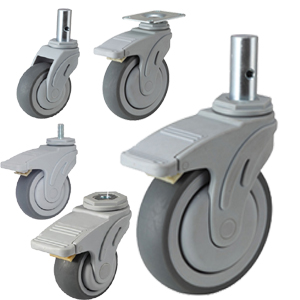- Best Price! Direct China Factory!
- Send Inquiry
WhatsApp/WeChat: 0086-137-36454395
Medical casters, also known as medical wheels or hospital casters, play a crucial role in the healthcare industry. They are designed to provide smooth and safe mobility for medical equipment, furniture, and devices within hospitals, clinics, and other healthcare facilities. Here are some key features of medical casters
Hygiene and Cleanliness: Medical casters are designed to meet strict hygiene standards. They are often made from materials such as stainless steel or antimicrobial polymers that are resistant to bacterial growth and easy to clean. This helps prevent the spread of infections and ensures a clean and sanitary environment.
Smooth and Quiet Operation: Medical casters are engineered to provide smooth and quiet operation. They incorporate high-quality bearings and precision manufacturing techniques to ensure minimal rolling resistance and noise generation. This feature is essential for maintaining a peaceful and comfortable atmosphere in healthcare settings.
Floor Protection: Medical casters are designed to minimize damage to the floors of healthcare facilities. They often feature non-marking materials or have soft tread surfaces that protect sensitive flooring, preventing scratches, scuffs, or marks. This is particularly important for maintaining the aesthetics and longevity of the facility's flooring.
Maneuverability and Control: Medical casters are designed to offer excellent maneuverability and control. They typically feature swivel functionality that enables multidirectional movement, allowing healthcare professionals to navigate equipment and furniture with ease, even in tight spaces. Some casters may also include locking mechanisms to provide stability when needed.
Load Capacity: Medical casters come in various load capacities to accommodate different equipment and furniture requirements in healthcare settings. They are available in light-duty, medium-duty, and heavy-duty options, ensuring that they can support the weight of medical devices, patient beds, surgical tables, and other equipment safely and reliably.
Anti-static Properties: In environments where electrostatic discharge can be a concern, such as operating rooms or sensitive medical equipment areas, anti-static medical casters are available. These casters are designed to prevent the buildup and discharge of static electricity, reducing the risk of damage to sensitive electronic components or patient safety.
Braking Systems: Many medical casters come equipped with braking systems for added safety and stability. These brakes can be foot-activated or hand-activated and allow healthcare professionals to secure equipment in place when required. Brakes are particularly important for mobile carts, stretchers, and other equipment that need to remain stationary during procedures or patient transfers.
Corrosion Resistance: Medical casters may also have corrosion-resistant properties to withstand frequent cleaning with disinfectants and exposure to moisture. This is essential for maintaining the longevity of the casters and preventing any degradation in performance due to corrosion.
Compatibility and Customization: Medical casters are available in various sizes and mounting options, allowing them to be compatible with a wide range of medical equipment and furniture. They can be customized to fit specific requirements, including wheel diameter, mounting plate dimensions, and specialized features such as directional lock systems or shock-absorbing capabilities.
Compliance with Standards: Medical casters are often manufactured and tested according to industry standards and regulations to ensure high quality and performance. They may comply with standards such as ISO 9001 (quality management system), ISO 13485 (medical device quality management system), or EN 60601 (safety and performance requirements for medical electrical equipment).
In summary, medical casters are designed with specific features to meet the unique demands of healthcare facilities. They prioritize hygiene and cleanliness, offer smooth and quiet operation, protect floors, provide maneuverability and control, accommodate different load capacities, incorporate braking systems, resist corrosion, and can be tailored to specific requirements. By choosing high-quality medical casters, healthcare professionals can enhance mobility, safety, and efficiency in their daily operations.




 English
English Spanish
Spanish German
German Russian
Russian Arabic
Arabic Portuguese
Portuguese Italian
Italian French
French Hebrew
Hebrew Turkish
Turkish